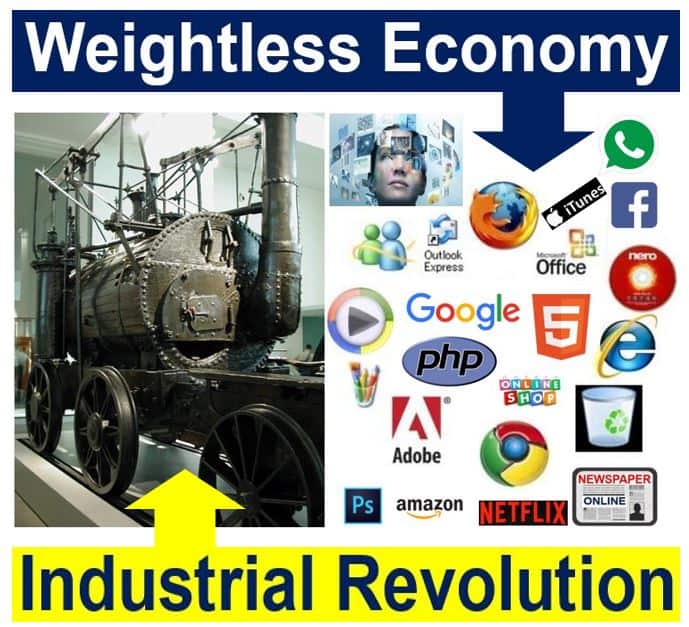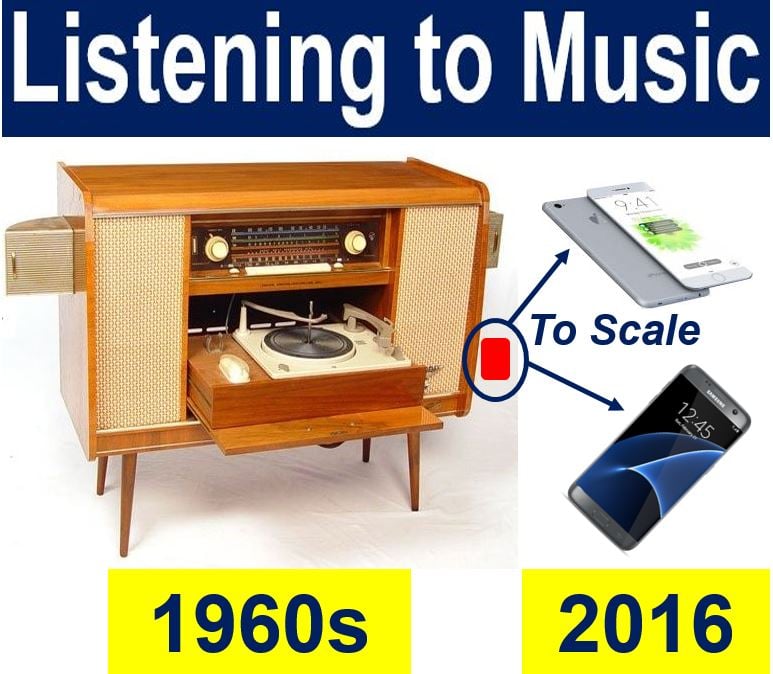The weightless economy, also known as the dematerialized economy, refers to the products and services that have no weight, they are abstract or intangible – you cannot touch them because they have no mass.
For example, computer software – which we download online or obtain from a disc – has no weight; you cannot see or touch it, it is abstract. However, it is a product that consumers use and usually have to pay for if they want it.
According to The Economist, the United States’ total output in the year 2001 weighed approximately the same as it did in 1901. However, the total value of that output, in real terms, was more than twenty times greater.
Much of the increase was due to the dramatic explosion of the weightless economy. *Intellectual capital today, rather than physical materials, is representing an increasingly greater proportion of GDP (gross domestic product) in most countries across the world.
* Intellectual capital refers to the collective knowledge of the employees in an organization or people in a society – this knowledge is used to create wealth.
 Great innovations during the Industrial Revolution were heavy beasts like the locomotive in the image above. The majority of new and exciting products in our modern economy are weightless.
Great innovations during the Industrial Revolution were heavy beasts like the locomotive in the image above. The majority of new and exciting products in our modern economy are weightless.
In modern history, the advanced economies have undergone two major milestones: 1. The industrial revolution. 2. The IT (information technology) and telecommunications revolution.
Our current post-industrial economy relies on IT and telecommunications – ICT (information and communications technology) – to produce high-value output of knowledge, exchangeable information and intangible goods.
Today’s weightless economy consists of ICT as well as intellectual assets/patents. copyrights, trademarks, images, electronic libraries, biotechnologies, and millions of other things that have appeared online over the past twenty years.
We are seeing an economy today, which emerged at the end of the last century, that is qualitatively quite different from the one that dominated throughout the 20th century.
 Even many of the tangible goods are considerably smaller today than they used to be. Consider the difference in the size of devices for listening to music. Our modern smartphones can also serve as telephones, for receiving and sending correspondence, video-conferences, reading newspapers and other documents, entering our online social networking websites, shopping, searching and finding documents, and watching movies and TV series.
Even many of the tangible goods are considerably smaller today than they used to be. Consider the difference in the size of devices for listening to music. Our modern smartphones can also serve as telephones, for receiving and sending correspondence, video-conferences, reading newspapers and other documents, entering our online social networking websites, shopping, searching and finding documents, and watching movies and TV series.
The weightless economy offers both the developed and emerging nations a high potential for growth.
The Knowledge Economy, part of the weightless economy, is the use of knowledge to generate values – both tangible and intangible. Knowledge technology helps to transport a part of human knowledge to machines. This knowledge can be utilized in various fields to generate economic value. The knowledge economy does not always need technology – it is also possible without it.
Next 20 years
Economists say that the economies of the world’s leading industrial nations will double in size by 2036 – as long as we do not have a devastating war or a catastrophic natural event like a killer asteroid impact or a mega volcanic eruption.
They also predict that virtually all that economic growth will come from things that have no weight. In other words, the weightless economy will grow dramatically, while the physical economy will either stay much the same, or may even shrink.
Many physical products we use today are much smaller than they used to be. Compare how most of us listen to music these days with the giant stereo equipment that once filled our living rooms in the 1960s and 1970s.
Our future lies in ideas, information, knowledge, and services. This is where greater value will be created.
 As you can see in this image, over a period of two decades the US economy grew from $5 trillion to over $9 trillion. However, nearly all of this growth was in the weightless economy. The rest of the economy grew very little. (Image: adapted from image.slidesharecdn.com. Credit: US DoC; Cap Gemini Ernst & Young)
As you can see in this image, over a period of two decades the US economy grew from $5 trillion to over $9 trillion. However, nearly all of this growth was in the weightless economy. The rest of the economy grew very little. (Image: adapted from image.slidesharecdn.com. Credit: US DoC; Cap Gemini Ernst & Young)
Weightless economy – three features
There are three main features of the weightless economy: 1. High initial development costs. 2. Infinite distribution or reproduction. 3. Low production costs.
Development Costs: virtually all the components of the weightless economy are extremely expensive to develop. Creating a new video game or hi-tech software requires a lot of money up front. However, as soon as you have the finished product, getting it to consumers is cheap and easy (compared to physical goods).
Unlimited Distribution: when Microsoft or Apple create a new software, they can then sell it to literally every single person in the world. In theory, if everybody globally wanted it, the product could be delivered to their computers within one day.
This would be impossible with, for example, a new car. If 7 billion people wanted the latest Ford Fiesta model, it would take several years to make them all, and deliver them to each customer.
Low Production Costs: if I create a new video game I can get a retailer like Amazon to sell it for me. Every time one is produced for a new customer (really it is just a copy), the costs are minimal, compared to producing units of physical products.
Digital and weightless economy
The term ‘weightless economy’ became extremely popular during the 1990s. Since then, other terms have become more fashionable. The Digital Economy – also known as the Internet Economy, the *New Economy, or Web Economy – refers to an economy based on digital computing technologies.
* The New Economy is a term that economists and journalists started using towards the end of the last century. They argued that the Internet, IT high-tech, other hi-tech, and globalization were completely transforming the economy – to such an extent, in fact, that the economic rules that had existed for centuries no longer applied.
Don Tapscott, a Canadian business executive, author, consultant and speaker, coined the term ‘Digital Economy’ in his book – The Digital Economy: Promise and Peril in the Age of Networked Intelligence – published in 1995. It was one of the first books to consider how the Internet would change the way people did business.
Weightless economy – where will it end?
I have two newspaper subscriptions – the Financial Times and the Wall Street Journal. I read both of them every day, each one at least 300 times annually. In all that time I have not physically touched the physical (printed) version of either publication.
Imagine how much one year’s worth of printed FTs and WSJs would weigh, and compare that to their weight in online or digital form – weightless.
If any man or woman aged 40 years or less walked into a newspaper office in the 1950s, they would be shocked by three things:
1. The amount of noise – this was mainly due to typewriters.
2. The amount of smoke – the majority of adults smoked in those days, and did so everywhere, even in movie theaters and airplanes!
3. The amount of physical things everywhere, especially paper. Desks had piles of paper on top of them.
The world has changed considerably. Modern offices are quiet places, desks are virtually completely free of paper. In fact, in many companies, a growing proportion of employees are working remotely – usually at home.
Digitalization and automation are advancing apace. Mark Carney, the Governor of the Bank of England said last week that over the next few decades robots will be taking over more and more jobs, pushing about fifteen million people across the United Kingdom out of work.
In prehistory, humans discovered how to make fire, we then invented the wheel, made things with bronze and iron, took a huge leap during the industrial revolution. Then came the ICT revolution and the weightless economy. Where will it all end – what will come next?
Research and development in artificial Intelligence – creating intelligent machines that work, behave and think like humans – is progressing apace. Several eminent scientists and business people, including Steven Hawking, Bill Gates and Elon Musk, believe that intelligent robots may soon be cleverer than we are. They say that that prospect frightens them.
Elon Musk said: “I think we should be very careful about artificial intelligence. If I had to guess at what our biggest existential threat is, it’s probably that. So we need to be very careful.”
“I’m increasingly inclined to think that there should be some regulatory oversight, maybe at the national and international level, just to make sure that we don’t do something very foolish.”
A few days later, Bill Gates made the following comment: “I am in the camp that is concerned about super intelligence. First the machines will do a lot of jobs for us and not be super intelligent. That should be positive if we manage it well.”
“A few decades after that though the intelligence is strong enough to be a concern. I agree with Elon Musk and some others on this and don’t understand why some people are not concerned.”
